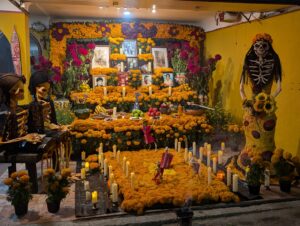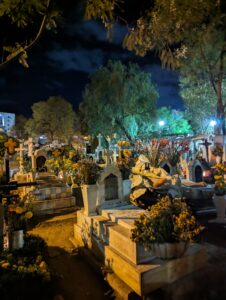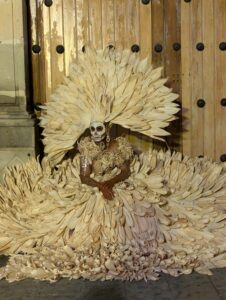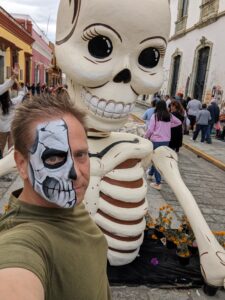Celebrating Life Through Death, One Candle at a Time
 Each year in late October, I return to Oaxaca not just as a traveler, but as a witness to something ancient, sacred, and profoundly alive.
Each year in late October, I return to Oaxaca not just as a traveler, but as a witness to something ancient, sacred, and profoundly alive.
The streets fill with color and smoke. Music echoes through candlelit cemeteries. And everywhere from quiet altars in family homes to parades bursting with skeletons and drums there’s a shared belief: our dead are not gone; they’ve simply crossed over for a while.
Death Arrives on Butterfly Wings
The roots of Día de Muertos reach deep into pre-Hispanic times, long before Catholicism arrived. The Zapotec, Mixtec, and other indigenous peoples believed death wasn’t an end just a new phase in a long spiritual cycle.
This belief beautifully aligns with one of nature’s most haunting synchronicities: the arrival of the monarch butterflies in central and southern Mexico around the same time. These delicate creatures, having traveled thousands of miles, are said to carry the souls of the dead back to visit their loved ones. You can feel it in the air the sense of return, of reunion.
Cemeteries That Glow With Joy
 In Oaxaca, cemeteries are not feared. They are lit literally with thousands of candles, flowers, and families sharing food, mezcal, and memories.
In Oaxaca, cemeteries are not feared. They are lit literally with thousands of candles, flowers, and families sharing food, mezcal, and memories.
One of my favorite places is the Xoxocotlán cemetery just outside the city. On the nights of October 31st and November 1st, it’s alive with marigolds, laughter, live bands, children playing among the tombs, and families sitting together around decorated graves. It’s not eerie it’s intimate. Death, here, is part of the family.
Compare that to cemeteries in the U.S., which are often silent, sterile, and somber. In Mexico, joy and remembrance coexist. You’re not afraid to be there. You’re invited to be there.
A Feast for the Spirits
In nearly every home and shop, you’ll find an ofrenda an altar to the dead. Photos of loved ones are surrounded by marigolds (cempasúchil), candles, favorite foods, cigarettes, bottles of mezcal, sugar skulls, and pan de muerto (a sweet bread made for the occasion).
The altars aren’t just decoration they’re invitations. They’re how you say, “You’re not forgotten. Come eat, drink, and be with us again.”
Building an ofrenda is an act of love. It’s about telling stories, sharing memories, and keeping the dead present in everyday life.
Dancing with Death: Parades and Processions
 Oaxaca’s comparsas street parades with brass bands, dancers, and giant puppets blur the line between life and death. People wear skull masks, devil costumes, and flowery skeleton suits. The energy is chaotic and beautiful.
Oaxaca’s comparsas street parades with brass bands, dancers, and giant puppets blur the line between life and death. People wear skull masks, devil costumes, and flowery skeleton suits. The energy is chaotic and beautiful.
You don’t watch these parades. You join them. Everyone becomes part of the procession dancing, laughing, and celebrating the absurdity and inevitability of death.
I remember being caught in one with a group of strangers. Within minutes, we were all swirling in rhythm, faces painted like calaveras, a wild mix of ritual and rebellion. In Oaxaca, death is not mocked it’s danced with.
Masks and the Modern Take on Tradition
 As a mask collector, I’m always drawn to the traditional wooden masks worn during performances and street celebrations often depicting skulls, devils, animals, or ancestral spirits.
As a mask collector, I’m always drawn to the traditional wooden masks worn during performances and street celebrations often depicting skulls, devils, animals, or ancestral spirits.
But in recent years, another visual tradition has taken root: face painting.
Particularly among women and children, the sugar skull face paint intricate, beautiful, and symbolic has become a way to embody death while celebrating life. It’s art, identity, and remembrance all in one.
In Oaxaca, tradition doesn’t just survive it evolves. And that, too, is a kind of resurrection.
Why I Keep Coming Back
There’s a phrase I once heard from an Oaxacan elder:
“Aquí, la muerte no es el final. Es solo otro invitado a la fiesta.”
(Here, death is not the end. It’s just another guest at the party.)
That’s what makes Day of the Dead in Oaxaca so powerful. It’s not about fearing death or mourning loss it’s about living fully, remembering deeply, and honoring those who came before us with music, mezcal, and memory.
I’ll return again this year.
No Comment